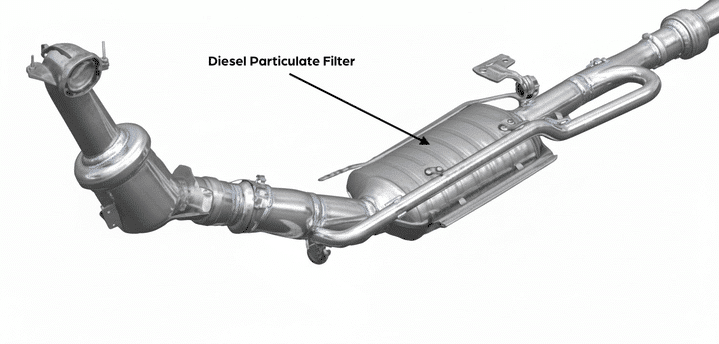DPF Faults P2463 & P246B: Restoring a Land Rover from Limp Mode
Mrs L’s Land Rover Discovery Sport had been running as normal when, without warning, it slipped into limp mode. Power dropped away, the car became difficult to manage on the M1 near Northampton, and the dashboard lit up with both the DPF and Engine Management lights.
For Mrs L, this wasn’t just inconvenient — it was worrying. Her Land Rover was a vehicle she depended on daily, and suddenly, it felt powerless. Added to that was the concern of an expensive repair bill and the possibility of long-term engine damage.
When she brought her Discovery Sport to Roade Main Garage in Northampton, she wanted certainty. No guesswork. No trial fixes. Just a clear diagnosis and the right repair, first time.
Before we explain how our team restored her Land Rover, it’s worth taking a closer look at the Diesel Particulate Filter itself, why it’s such a vital component, and how it can cause exactly this type of limp mode fault.
A Quick Guide to the Land Rover Diesel Particulate Filter
Modern Land Rover diesels are fitted with a Diesel Particulate Filter (DPF). Its purpose is to capture the fine soot created whenever fuel burns, stopping it from being released into the atmosphere. The filter holds this soot until the exhaust reaches the high temperatures required to burn it away in a process called regeneration.

The system works well, but it depends on the right conditions. If a vehicle is mostly driven on short trips or in slow-moving traffic, the exhaust often doesn’t get hot enough to complete regeneration. When that happens, soot begins to build inside the filter.
As the build-up increases, the DPF becomes restricted and struggles to do its job properly. At that point, dashboard warnings will appear — and if the issue is not dealt with, the Land Rover will eventually be forced into limp mode to protect the engine.
That’s why any DPF warning deserves attention. What begins as a minor restriction can soon turn into a serious blockage, affecting performance, driving up repair costs, and in severe cases putting the engine itself at risk. Want to learn more about the DPF? Check out our previous blog, which goes into more detail.
Starting the Diagnosis – Fault Codes P2463 & P246B
When Mrs L’s Land Rover Discovery Sport arrived at our workshop, the dashboard was already warning her of trouble. Both the Engine Management Light and the DPF light were on, and the car had switched itself into limp mode, leaving it slow and frustrating to drive.
Our first step was to connect our dealer-level diagnostic equipment to the Land Rover’s system. The scan revealed two key fault codes:
- P2463-00 – Diesel Particulate Filter restriction, soot accumulation. This confirmed that the filter was badly restricted, with soot levels well above the safe limit.
- P246B-00 – Vehicle conditions incorrect for DPF regeneration. This showed the filter had been unable to regenerate, often caused by repeated short trips or low-speed journeys where the exhaust never reaches the temperature required.
For our technicians, these codes were a valuable first step, but they were far from the whole story. A fault code highlights what the car is experiencing, but it doesn’t explain why it happened. At Roade Main Garage in Northampton, we use codes as the starting point for diagnosis, never the conclusion.
To protect the engine and ensure the correct repair, the next stage was to carry out a full investigation, checking every area that could have contributed to the blockage before moving forward.
Investigating the DPF Fault Step by Step
With the fault codes confirmed, our next job was to investigate further and uncover why Mrs L’s Land Rover had dropped into limp mode. At Roade Main Garage, that means working through a structured process rather than jumping to conclusions.
Here’s how our technicians approached the case:
- Engine oil check – A blocked DPF can lead to failed regenerations, which often cause fuel to mix with the oil. In this case, the oil showed signs of dilution. That meant an oil and filter change would be essential later in the repair to protect the engine.
- Air filter inspection – A clogged or damaged air filter can restrict airflow, forcing the engine to run rich and generate excess soot. The air filter was in good condition, so it was ruled out as a contributing factor.
- DPF pressure readings – Using dealer-level equipment, we measured the pressure across the filter. The results confirmed the soot build-up was causing a serious restriction, consistent with the limp mode Mrs L reported.
- Internal DPF check – We examined the filter for internal issues such as cracks or melting. None were found, meaning the filter itself did not need replacement.
- Intake and boost system inspection – Finally, we checked the intake and turbo system for leaks or weaknesses that could have contributed to the blockage. No faults were detected.
By carefully working through these checks, we were able to rule out other potential issues and confirm that the fault was a soot overload. With the cause identified, the next step was to move on to repairing the Land Rover.
If your Land Rover is showing similar warning lights or has gone into limp mode, call our team on 01604 862262 before the issue gets worse.
The Repair – How We Restored the Land Rover’s DPF
After the checks confirmed that there was a soot overload and signs of oil dilution, our next task was to return Mrs L’s Land Rover to full health. At this point, the work needed to be carried out with care and accuracy, using a structured process to ensure that the fault was properly resolved.
Here’s how our team completed the repair:
- Oil and filter service – Because the oil was diluted with fuel, we replaced both the oil and the filter. This protected the engine from premature wear and ensured it was running on clean, healthy oil.
- DPF clean and regeneration – We carried out a controlled regeneration procedure to burn away the excess soot and clear the restriction inside the filter.
- Adaptations reset – Once soot levels were back within manufacturer specifications, we reset the system’s adaptations. This allowed the ECU to recognise that the filter was clean and to manage future regenerations correctly.
- Fault memory clear and validation checks – Finally, we cleared the stored fault codes and ran validation checks. With no warnings present and the filter restored, Mrs L’s Land Rover was back to full working order.
Before returning the vehicle, we also advised Mrs L on how driving conditions affect DPF regeneration. By understanding which journeys support the process, she could help prevent the same issue from occurring again.
The Result – Land Rover Back to Full Health

With the repair completed, Mrs L’s Discovery Sport was back to full working order. The dashboard warnings had cleared, limp mode was lifted, and the vehicle once again delivered the performance she expected.
For Mrs L, the difference was instant. Instead of a sluggish and frustrating drive, she left our workshop with a Land Rover that felt strong, responsive, and dependable again.
That’s the benefit of choosing expert care — finding the root cause, carrying out the right repair, and returning the car in a condition the driver can trust.
Don’t Ignore Your DPF Warning – Call Us Today
If your Land Rover’s DPF light has appeared, it’s important not to delay. These systems are complex and need professional attention to fix correctly. At Roade Main Garage in Northampton, our technicians use dealer-level equipment and expert knowledge to trace the real fault and repair it properly, first time.
We deliver the same technical accuracy you’d expect from a main dealer, but at the value of a trusted independent garage. That means your Land Rover receives the right repair without the inflated costs.
Why drivers choose Roade Main Garage:
- Dealer-level diagnostic equipment and repair procedures
- Skilled technicians who uncover the cause, not just the symptom
- Premium vehicle care with a 12-month parts and labour guarantee
- Courtesy car options available to keep you moving
- Clear, itemised quotes with no hidden extras
We’re proud to hold a {{average-rating}}-star Google rating from {{review-count}} satisfied customers who rely on us for honest, expert service.
Whether your Land Rover is showing a DPF warning, stuck in limp mode, or down on performance, call our team on 01604 862262 to book your appointment.


